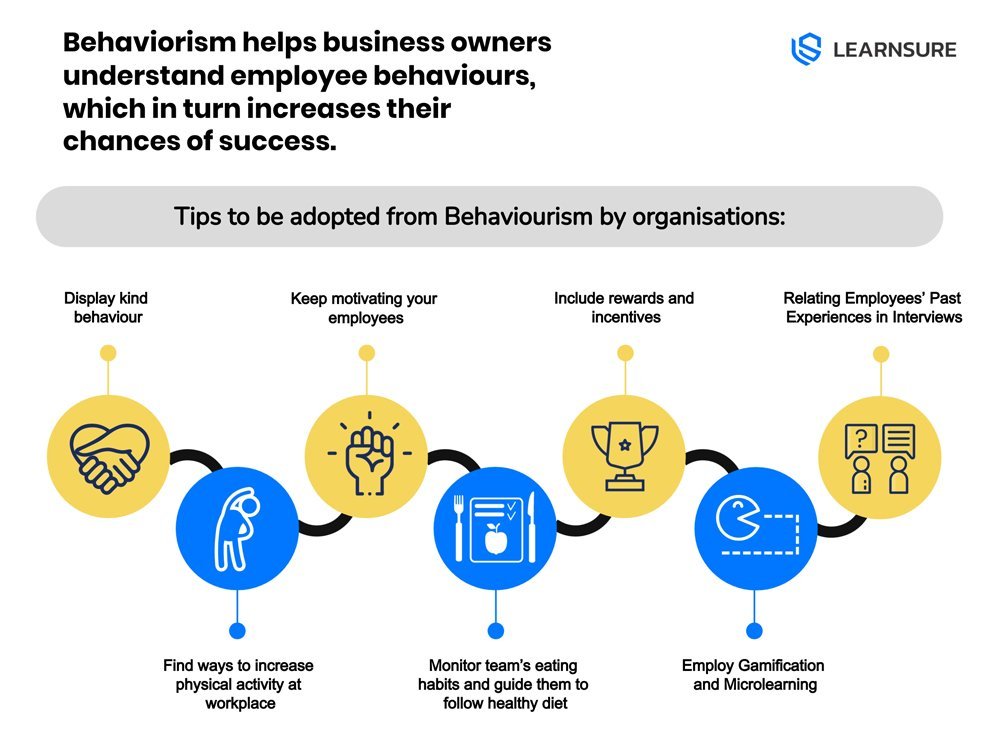Behaviourism to foster a productive work environment
Behaviourism is a psychological concept developed by B. F. Skinner. Many people believe behaviourism can be applied in places like schools and kindergartens and not as part of workplace training solutions. However, the story is entirely different.
Business owners have a lot to learn from behaviourism and related concepts. It can help them understand employee behaviours, which in turn increases their chances of success.
This article will describe behaviourism and show you how it can make your employees more productive.
What Is Behaviorism?
One of the most useful theories that can explain workplace behaviour is the reinforcement theory. Essentially, employees tend to keep reinforced behaviours and dispense with those that aren’t. It also suggests modifying past behaviours so that their impact on present behaviours is limited or neutralised.
Provide people with positive reinforcement and they are more likely to repeat their actions. As a result, when you offer employees various incentives, you can expect their production to increase since they will keep doing the actions you rewarded them for.
Other forms of behaviour in your business can also influence your workplace organization. For instance, your employees’ leadership style and personality are reliable indicators of how they will perform. To that end, you can set up interviews to evaluate candidates and employees and determine if they will fit in with the company culture.
Moreover, organizational behaviour deals with a group and individual dynamics. It aims to understand behaviour in the workplace and develop ways to predict how employees will behave. This method can help you control actions detrimental to your company.

What Can Business Owners Take Away From Behaviorism?
By now, you may have already reached some conclusions about how you can take advantage of behaviourism to build a more productive workplace. Here’s how you can follow the abovementioned principles to improve your corporate training and create an ideal business environment:
Display Kind Behavior
Treating your employees in the best way possible will help develop a positive atmosphere and a loyal community appreciative of the leader’s consideration. If you behave kindly with your employees, they’re likely to return the favour and be more comfortable doing their daily jobs.
To achieve this goal, you can perform various acts of kindness. For example, you can give away a branded coffee mug to your employee. Even a simple ‘Thank You’ is a small but powerful way of showing your employees that you appreciate their efforts. This will drive them to remain productive, knowing that they are working in a rewarding environment.
Generate Motivation
To help your employees feel motivated, you can empower them to solve various problems and make workplace decisions. Another great idea is to provide your employees with the opportunity to take part in training activities or flexible work schedules. The motivation aspect applies to all departments, from sales development to call centres.
Include Rewards and Incentives
Positive reinforcement is arguably the easiest way to achieve higher production. It’s also the most desirable since it goes easy on every team member involved. As previously mentioned, the technique comes down to recognizing and rewarding employees for preferred behaviours, such as an outstanding presentation, report, or pitch deck.
The most effective way of imparting positive reinforcement is to do it periodically. You don’t want your employees to start expecting rewards for every single task performed. They should be included intermittently so that your team doesn’t get used to them.
Moreover, try to identify rewards that have intrinsic value for your employees. For example, a well-thought-out note, plum assignment, or simple praise in front of the whole team will make your employees feel appreciated and motivated to perform on the same level or even better.
Don’t forget to always include feedback in the workplace, whether it’s praise or constructive criticism. Providing feedback is beneficial to your employees since it allows them to see where they performed well and which areas need improvement. In doing so, your employees can grow and work on the skills necessary to contribute to your company’s growth.
Relating Employees’ Past Experiences in Interviews
To predict how prospective employees will act in certain situations, you should conduct interviews to see how they behaved in the past. You can discuss with a candidate if specific past problems could have been resolved differently. If the prospect is fit for the job, they should know how to relate their experience to your business.
Applying Organizational Behavior Management (OBM)
Many people refer to workplace behaviourism as organizational behaviour management. All of the methods previously mentioned are part of OBM and all of them have the same goal – making your employees more productive.
As we’ve already discussed, there are many ways to increase workplace efficiency. But the business environment has evolved significantly, which is why you should consider adding a technological element to your OBM. Here are a few examples:
Get Your Employees Moving Around
If you’re running a business that requires your team to sit for hours on end at their desks, you should find a way to increase their physical activity. This will keep them in good health and maintain workplace productivity. A great way to do this is to introduce an app that jingles for a couple of minutes every hour, signalling that it’s time to get out of their seats and move around.
Track Your Team’s Exercise and Eating
If your business entails frequent travel, it usually means less exercise and poor eating. To prevent this, you can get your employees apps that monitor their activity and diet while on a business trip. It will keep them healthy and more likely to get the job done.
Employ Gamification and Microlearning
Video games are a motivating addition to any business. Modules like leader boards and badges make workplace learning fun and engage your employees. This creates an environment conducive to greater productivity and growth.
Furthermore, use microlearning activities to make your employee training more efficient and time-saving. It comes in various structures and includes engaging content.
Final Thoughts
Even though it may have sounded far-fetched at first, behaviourism has numerous implications in the workplace. If applied correctly, your employees will become more efficient.
To ensure you’re taking the right approach, contact the experts at Learnsure. We’ll show you how behaviourism can help any business and implement many other methods that will become an integral part of future workplace learning. Book a demo and check out our services for yourself.



